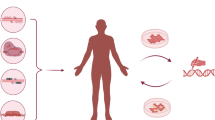Abstract
Lentiviral infection is often used to integrate genetic material into cells to stably express transgenes of interest. Depending on the location of integration into the host genome, readthrough expression of the lentiviral cargo can occur via an upstream endogenous promoter, which is typically an unwanted phenomenon because it can result in dysfunctional expression. The purpose of this study was to demonstrate that readthrough expression can be a wanted phenomenon for expressing functional proteins while at the same time reducing the size of the lentiviral transfer plasmid. Readthrough expression was used to generate HEK293 cell lines stably expressing fluorescent reporter proteins, reporter protein-antibiotic resistance fusion proteins for selection, and the vascular endothelial growth factor receptor 2. The generated proteins were all functional, as demonstrated by their ability to fluoresce, confer antibiotic resistance, and participate in receptor-mediated signalling, respectively. Therefore, we suggest that the mechanism of readthrough expression may have further applications in the expression of larger genes or genetic circuits (e.g. cell-based therapeutics), where the lentiviral cargo limit is stretched to the maximum.



Similar content being viewed by others
References
Dull T, Zufferey R, Kelly M, Mandel RJ, Nguyen M, Trono D, Naldini L (1998) A third-generation lentivirus vector with a conditional packaging system. J Virol 72(11):8463–8471
Koldej RM, Anson DS (2009) Refinement of lentiviral vector for improved RNA processing and reduced rates of self inactivation repair. BMC Biotechnol 9:86
Mosabbir AA, Truong K (2016) Genomic integration occurs in the packaging cell via unexported lentiviral precursors. Biotechnol Lett 38(10):1715–1721
Mosabbir AA, Truong K (2017) Ca(2+)-mediated rewiring of cell homing and fusion to VEGF sources. Cell Calcium 65:31–39
Nagai T, Ibata K, Park ES, Kubota M, Mikoshiba K, Miyawaki A (2002) A variant of yellow fluorescent protein with fast and efficient maturation for cell-biological applications. Nat Biotechnol 20(1):87–90
Ohkura M, Sasaki T, Kobayashi C, Ikegaya Y, Nakai J (2012) An improved genetically encoded red fluorescent Ca2+ indicator for detecting optically evoked action potentials. PLoS One 7(7):e39933
Rizzo MA, Springer GH, Granada B, Piston DW (2004) An improved cyan fluorescent protein variant useful for FRET. Nat Biotechnol 22(4):445–449
Roulston C, Luke GA, de Felipe P, Ruan L, Cope J, Nicholson J, Sukhodub A, Tilsner J, Ryan MD (2016) ‘2A-like’ signal sequences mediating translational recoding: a novel form of dual protein targeting. Traffic 17(8):923–939
Schambach A, Galla M, Maetzig T, Loew R, Baum C (2007) Improving transcriptional termination of self-inactivating gamma-retroviral and lentiviral vectors. Mol Ther 15(6):1167–1173
Truong K, Khorchid A, Ikura M (2003) A fluorescent cassette-based strategy for engineering multiple domain fusion proteins. BMC Biotechnol 3(1):1–8
White M, Whittaker R, Gandara C, Stoll EA (2017) A guide to approaching regulatory considerations for lentiviral-mediated gene therapies. Hum Gene Ther Methods 28(4):163–176
Yang SH, Cheng PH, Sullivan RT, Thomas JW, Chan AW (2008) Lentiviral integration preferences in transgenic mice. Genesis 46(12):711–718
Funding
This work was supported by the Canadian Institutes of Health Research [#PJT-156317] and the Natural Science and Engineering Research Council NSERC [#RGPIN-2019-04183].
Author information
Authors and Affiliations
Corresponding author
Ethics declarations
Conflict of interest
The authors declare no financial or competing interests.
Consent for publication
All authors have given approval to the final version of the manuscript.
Additional information
Publisher's Note
Springer Nature remains neutral with regard to jurisdictional claims in published maps and institutional affiliations.
Supplementary Information
Below is the link to the electronic supplementary material.
Supplementary file1 Fluorescence microscopy timelapse of HEK293 cells stably transfected with VEGFR2 and RCaMP after stimulation with VEGF (AVI 1347 kb)
Rights and permissions
About this article
Cite this article
Jadav, A., Truong, K. Generation of stable cell lines using readthrough expression from lentiviral integration. Biotechnol Lett 43, 2131–2136 (2021). https://doi.org/10.1007/s10529-021-03186-y
Received:
Accepted:
Published:
Issue Date:
DOI: https://doi.org/10.1007/s10529-021-03186-y




